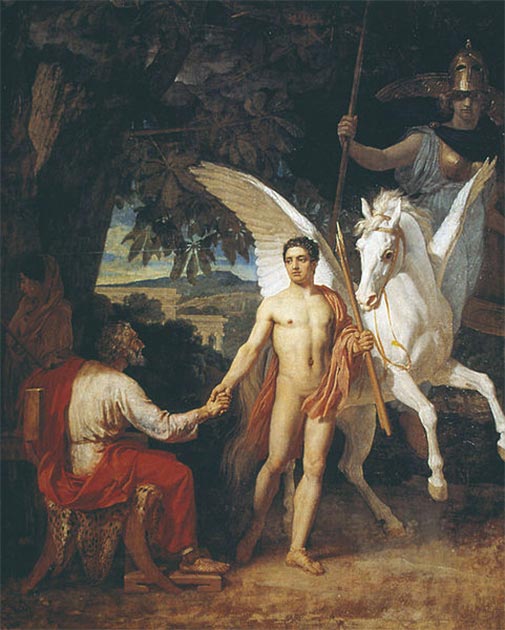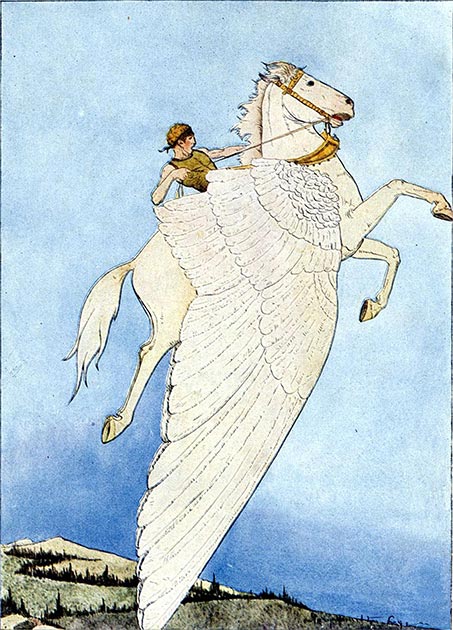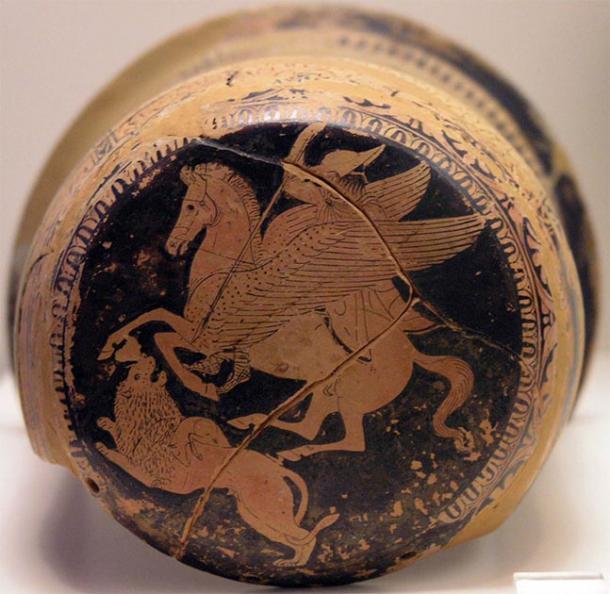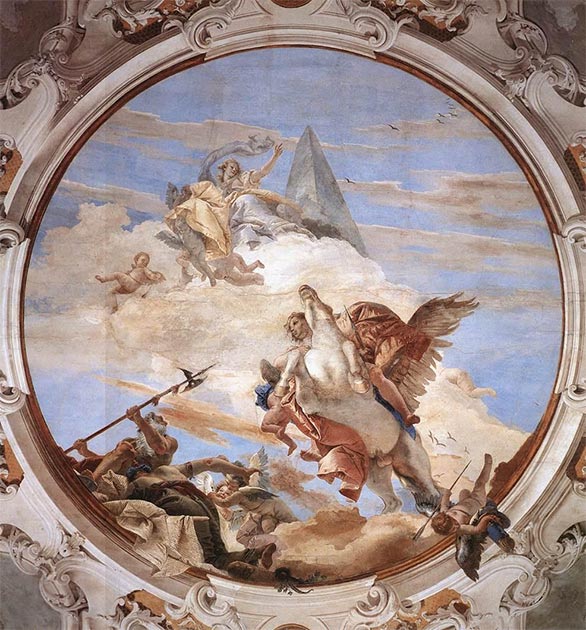
Bellerophon – The Escapades of a Bad Boy Hero With Hidden Lessons
Bellerophon is a well-known hero in Greek mythology. He is best-known for the slaying of the Chimera, a monstrous fire-breathing creature with three heads. The hero was able to accomplish this feat with the aid of Pegasus, the winged horse. In classical art, the three figures are often depicted together. The story of Bellerophon, however, ends in tragedy. It was his hubris, or excessive pride that resulted in the hero’s downfall. This may be a lesson that the ancient Greeks sought to present through the story of Bellerophon.
Who Was Bellerophon?
The ancient writers were not in full agreement regarding the parentage of Bellerophon. According to Homer’s Iliad, for example, his father was Glaucus, the King of Ephyre (the old name of Corinth). Glaucus was the son of Sisyphus, who was famous for his craftiness. By deceiving the gods, however, Sisyphus was given a unique punishment in the Underworld.
The dead king was forced to roll a huge boulder up a steep hill. Unbeknownst to him, however, Zeus had placed an enchantment on the boulder, causing it to roll down before Sisyphus was able to reach the summit. Therefore, Sisyphus was condemned to an eternity of labor without the desired results. His son, Glaucus too, has a number of interesting stories attached to him. According to one legend, the king fed human flesh to his mares, and in an ironic twist of fate, was devoured by them himself.
Although Homer does not provide the name of Bellerophon’s mother, other sources name her as Eurymede (or Eurynome), the daughter of Nisus, the King of Megara. Considering that both Glaucus and Eurynome were mortals, Bellerophon would have been completely mortal. Some sources, however, claim that Bellerophon’s father was not Glaucus. According to Hesiod’s Catalogue of Women, for instance, Zeus made a vow that Glaucus should not have any children of his own. Hesiod goes on to say that Eurymede laid in the arms of Poseidon, and as a result, gave birth to Bellerophon. Thus, in this account, Bellerophon was a demi-god.

Depiction of the ancient Greek god Poseidon, who was said to be the farther of Bellerophon. (Public domain)
Murder and Exile
In any case, Bellerophon was exiled from his home, as he had committed a murder. According to one version of the myth, the hero had killed Bellerus, a nobleman of his city. This version of the myth also explains that it was due to his slaying of Bellerus that the hero gained his name ‘Bellerophon’.
Prior to that incident, he was known as Hipponous. Alternately, Bellerophon is said to have murdered his own brother, who was known either as Deliades, Peiren, or Alcimenes. The myths, however, do not recount the circumstances of the murder. Having been exiled from Corinth, Bellerophon made his way to Argos.
Bellerophon arrived at the court of Proetus, the King of Tiryns. The hero was welcomed by the king, treated as a guest, and was purified of his crime. According to Homer, Proetus had a wife named Anteia. Other sources, however, claim that the queen was a woman by the name of Stheneboea. In any case, the queen fell in love with Bellerophon, and began making advances to the hero.

A pebble mosaic depicting Bellerophon’s battle with the Chimera, Rhodes Archaeological Museum. (Speravir / Public domain)
Bellerophon, however, was not interested in her, and rejected her offers. Feeling slighted, Anteia/Stheneboea went to her husband, and falsely accused Bellerophon of having made indecent proposals to her. She also urged Proetus to have Bellerophon killed. Although the king believed his wife, he was unwilling to kill the hero, as he was his guest and was therefore protected by xenia, the sacred rule of hospitality. Proetus was aware that if he were to break this rule, he could face divine retribution.
Proetus’ Cunning Plan
Therefore, Proetus came up with a plan, in which Bellerophon would be killed by someone else. One day, the king called for the hero, and asked him to deliver a sealed tablet to Iobates, the King of Lycia, and Anteia/Stheneboea’s father. Proteus’ message to Iobates was simple – kill the bearer of this tablet. Bellerophon, unaware of the danger he was putting himself into, did as he was told, and brought the tablet to Lycia. According to Homer’s version of the myth, Iobates welcomed Bellerophon generously, and threw a feast in honor of the hero every day for the next nine days.
Finally, on the morning of the tenth day, Iobates asked Bellerophon for the tablet that Proteus had sent to him. As the king opened the tablet, and read the message from his son-in-law, he was shocked. Iobates was aware that since he had entertained Bellerophon as a guest during the last nine days, the hero was protected by xenia. The king was aware that he should not harm his guest. At the same time, however, he was obliged to fulfil his son-in-law’s request. Therefore, he decided to do what Proetus did, i.e. to let someone else kill Bellerophon. Instead of sending Bellerophon to another king, however, Iobates decided to give the hero an impossible task to accomplish.

The picture shows the time when Bellerophon said goodbye to King Iobates before completing the ‘impossible task’ of slaying the beast, the Chimera. (Aleksandr Ivánov / Public domain)
There lived in the neighboring region of Caria a monster called the Chimera. In Hesiod’s Theogony, the monster is said to be the offspring of Typhon and Echidna. Hesiod describes the creature as follows, “but she (Echidna) bore Chimera, who breathed invincible fire, a terrible great creature, swift-footed and strong. She had three heads: one of a fierce lion, one of a she-goat, and one of a powerful serpent.” In the Iliad, Homer provides a similar description of the monster, which is as follows, “grim monster sprung of the gods, nothing human, all lion in front, all snake behind, all goat between, terrible, blasting lethal fire at every breath!”
Obtaining Pegasus and the Slaying of the Beast
In both the Theogony and the Iliad, Bellerophon is acknowledged as the slayer of the Chimera. Neither source, however, mentions how the hero accomplished this impossible feat. In all versions of the myth, Bellerophon obtains the aid of Pegasus in his quest to slay the Chimera. Pegasus was the famous winged-horse of Greek mythology. Like the Chimera, Pegasus was also the offspring of a monster, the Gorgon Medusa.

Depiction of the mythical horse Pegasus. (storm / Adobe stock)
According to Greek mythology, when Medusa was decapitated by the hero Perseus, Chrysaor (whose name means ‘he who has a golden sword’) and Pegasus sprang from the monster’s neck. The father of Chrysaor and Pegasus is said to have been Poseidon. Ovid, in his Metamorphoses, claimed that Poseidon, in the form of a bird, mated with the Gorgon, causing her to become pregnant. Her two children, however, kept in her neck, until she was killed by Perseus.
There are various versions as to how Bellerophon came into possession of Pegasus. In Hesiod’s Catalogue of Women, for example, Pegasus is said to have been gifted to Bellerophon by his father, i.e. Poseidon.
According to another version of the tale, found in Pindar’s Olympian Odes, Bellerophon is said to have tried to tame the winged-horse as it came to Corinth’s spring, but all his attempts ended in failure. Eventually, the goddess Athena came to the hero in a dream, and revealed to him how he might tame Pegasus. The goddess gave Bellerophon a magic bridle, and a golden headband. Additionally, she told him that he should sacrifice a snow-white bull to Poseidon, and to show the god the bridle.
When Bellerophon woke up, he did as he was told, and succeeding in capturing Pegasus. Pausanias, in his Description of Greece, on the other hand, wrote that Athena herself tamed Pegasus, and gifted it to Bellerophon.

Depiction of Bellerophon riding Pegasus. (Mary Hamilton Frye / Public domain)
Most of the ancient sources do not elaborate on the battle between Bellerophon and the Chimera. In the Bibliotheca of Pseudo-Apollodorus, Bellerophon is said to have mounted Pegasus for his fight against the Chimera. As the hero and his steed were in the air, they were able to avoid the flames spewed by the monster. Pseudo-Apollodorus goes on to say that the hero slew the Chimera with his bow and arrows.
The depiction of this battle in classical art, however, is different from Pseudo-Apollodorus’ account. A terracotta relief plaque in the British Museum, for instance, shows Bellerophon combating the Chimera with a sword. Incidentally, the plaque also portrays Pegasus without wings. More commonly, however, the hero is shown wielding a spear for his fight against the Chimera. This is visible in the depiction of the battle on ancient Greek pottery, as well as on mosaics.

Bellerophon on Pegasus spears the Chimera, on an Attic red-figure epinetron, 425–420 BC. (National Archaeological Museum of Athens / CC BY-SA 2.5)
More Attempts on Bellerophon’s Life
After slaying the Chimera, Bellerophon returned to Iobates. Whilst the king may have been happy that the ferocious monster was no more, he was probably disappointed to see that Bellerophon was still alive. According to both Homer and Pseudo-Apollodorus, Iobates did not give up, and gave the hero another impossible task to accomplish. This time, the king requested Bellerophon to subdue the Solymi, a barbarian tribe that ravaged the borders of Lycia. Unfortunately, there is little information, either in literature or art, about the battle between Bellerophon and the Solymi.
Suffice to say, Bellerophon accomplished this task as well, and triumphantly returned to Iobates. The king tried to have Bellerophon killed once more, this time by sending him against the legendary Amazons. Homer and Pseudo-Apollodorus both report that Iobates tried to kill Bellerophon one last time by sending his best warriors to ambush the hero. Bellerophon easily slayed all of them.
Having tried and failed to kill so many times, Iobates was forced to acknowledge that Bellerophon was more than human. In Pseudo-Apollodorus’ account, Iobates showed Bellerophon the tablet sent by Proetus, thereby revealing to the hero the reason he had been sent on those dangerous missions. The king wanted to make amends to Bellerophon, or perhaps he feared that the hero would take revenge on him.
Therefore, Iobates asked Bellerophon to stay with him, and gave him the hand of his daughter, Philonoe, in marriage. Pseudo-Apollodorus concludes the myth by saying that when Iobates died, Bellerophon inherited his kingdom. Although Homer’s account is similar to Pseudo-Apollodorus’, it differs slightly in that the king gave Bellerophon half his royal privileges whilst he was still alive.
- Unravelling the True Story of the Legendary Trojan Horse
- Cacus – The One Who Dared Cross Hercules
- The Greek God Apollo and His Mystical Powers
Not Always a Happy Ending
The myth of Bellerophon, however, does not always end on this happy note. Homer, for instance, wrote that “but the day soon came when even Bellerophon was hated by all the gods. Across the Alean plain he wandered, all alone, eating his heart out, a fugitive on the run from the beaten tracks of men.” Homer, however, does not mention the cause of Bellerophon’s fall from grace.
Instead, other sources have to be consulted to understand what happened to the hero. Pindar, in his Isthmian Odes, for instance, claimed that Bellerophon desired to fly on Pegasus’ back to the heavens, so as to share in the company of the gods. The hero, however, was thrown by Pegasus down to Earth. Pegasus is said to have continued its journey, and was given a place in Zeus’ stalls when it reached the heavens.

Bellerophon trying to reach the heavens by riding Pegasus. (Giovanni Battista Tiepolo / Public domain)
In another version of the myth, found in Pseudo-Hyginus’ Astronomica, Bellerophon almost reached the heavens on Pegasus. The hero, however, decided to look down at the Earth, and was suddenly struck by fear. As a result, he fell from Pegasus, and was killed.
In Pseudo-Hyginus’ Fabulae, on the other hand, Bellerophon is said to have merely dislocated his hip during the fall. In the Astronomica, Pegasus continued its journey to the heavens, and was eventually placed by Zeus amongst the constellations. Incidentally, even after the Classical period, Pegasus continued to be used as an emblem. For instance, it is a common element in heraldry, and is found on the flag of Tuscany. In modern times, the flight of Pegasus to the heavens is considered to be a symbol of poetic inspiration.
Bellerophon, however, does not seem to have fared as well. In the various accounts of the hero’s fall, it seems that the tragedy was brought about either by Bellerophon himself or by Pegasus, and had nothing to do with the gods. One popular version of the myth, however, states that Zeus, seeing what Bellerophon was trying to do, sent a gadfly to sting Pegasus, thus causing it to throw the hero off its back.
The involvement of Zeus in this version of the myth serves as a lesson against hubris. Bellerophon, a mere mortal (or a demi-god at best) saw himself as an equal of the gods, and tried to reach their home with his own effort. For the ancient Greeks, this was a display of excessive pride, which the gods despised. As a consequence, Zeus punished the hero by having him thrown back to Earth.
Top image: According to ancient Greek mythology, the hero Bellerophon with the aid of the winged horse Pegasus slew the monstrous creature known as the Chimera. Source: insima / Adobe stock
By Wu Mingren
References
Atsma, A. J., 2017. Bellerophon (Bellerophontes). [Online]
Available at: https://www.theoi.com/Heros/Bellerophontes.html
Atsma, A. J., 2017. Chimera (Khimaira). [Online]
Available at: https://www.theoi.com/Ther/Khimaira.html
Atsma, A. J., 2017. Pegasus (Pegasos). [Online]
Available at: https://www.theoi.com/Ther/HipposPegasos.html
Encyclopedia Mythica, 1997. Bellerophon. [Online]
Available at: https://pantheon.org/articles/b/bellerophon.html
greek-gods.org, 2018. Bellerophon. [Online]
Available at: https://www.greek-gods.org/greek-heroes/bellerophon.php
greekgodsandgoddesses.net, 2017. Chimaera. [Online]
Available at: https://greekgodsandgoddesses.net/myths/chimaera/
New World Encyclopedia, 2020. Chimera (mythology). [Online]
Available at: https://www.newworldencyclopedia.org/entry/Chimera_(mythology)
The British Museum, 2020. votive plaque / relief. [Online]
Available at: https://research.britishmuseum.org/research/collection_online/collection_object_details.aspx?images=true&objectId=461857&partId=1
The Editors of Encyclopaedia Britannica, 2018. Bellerophon. [Online]
Available at: https://www.britannica.com/topic/Bellerophon-Greek-mythology
The Editors of Encyclopaedia Britannica, 2018. Glaucus. [Online]
Available at: https://www.britannica.com/topic/Glaucus-Greek-mythology
The Editors of Encyclopaedia Britannica, 2019. Pegasus. [Online]
Available at: https://www.britannica.com/topic/Pegasus-Greek-mythology
The Editors of Encyclopaedia Britannica, 2019. Sisyphus. [Online]
Available at: https://www.britannica.com/topic/Sisyphus
www.greekmythology.com, 2020. Bellerophon. [Online]
Available at: https://www.greekmythology.com/Myths/Heroes/Bellerophon/bellerophon.html
www.greekmythology.com, 2020. Pegasus. [Online]
Available at: https://www.greekmythology.com/Myths/Creatures/Pegasus/pegasus.html















